Mixed Protein Diets for Pets


Mixed Protein Diets for Healthy Pets
Mixed Protein Diets are recipes that have more than one meat source included e.g. a diet made up of white and red meats or any other mixed combination of proteins. Mixed Protein Diets are a great introduction to raw feeding, and remain ideal for ongoing feeding for the vast majority of dogs throughout their lives.
Meat is an essential component of a dog’s diet, providing them with protein, amino acids and other essential nutrients to help them thrive. Different protein sources will all provide different ratios of these nutrients that our dogs fundamentally need.
Beyond the health aspects of a varied diet, feeding a mix of proteins means your dog will also be stimulated by the different flavours coming from all the different protein sources, making meals even more enjoyable for them.
Another important benefit of feeding pets Mixed Protein Diets is to expose them to as many different proteins as possible to reduce the chance of them becoming intolerant or sensitive to them. If you only ever ate beef and potatoes for your whole life (pretty great, we know, but stick with us) your digestive system might get a rude shock if you tried to eat salmon and broccoli one day. The high levels of omega-3 fatty acids in the salmon, as beneficial as they are, may give you diarrhoea because your digestive system isn’t used to the fat levels. Then the broccoli, with its beneficial sulphur-based phytonutrients might cause gas and bloating because your digestive system isn’t used to this kind of fibre to digest.
It’s not likely for humans to just eat the same thing day in and day out, but it is unfortunately, more common for dogs to be on one food and suffer from digestive discomfort when they are introduced to something new. By feeding a varied diet, you’ll be reducing their chances of developing an intolerance, sensitivity or digestive upsets from new foods.
According to veterinarian Dr. Jean Dodds;
“Feeding our pets a restricted diet for months or years creates an environment inside their guts where any new food is considered a foreign invader, and the bacteria don’t know what to do with it. This often results in the gas, bloating and loose stools that perplex so many well-intentioned pet parents as they seek to “transition” their four-legged companions from one food to another.
Single formula diets promote nutritional inadequacy.
No one dietary formula, no matter how “complete and balanced” it is, can meet all of an animal’s nutritional needs over an extended period.
Think of some of the healthiest foods in the world — let’s say spinach, wild salmon, sweet potatoes and blueberries. Eating these foods would provide an excellent protein source as well as a wide variety of phytonutrients. But, eaten every day, even these healthy foods will create nutritional deficiencies over time.”
This is why at Big Dog Pet Foods, we’re committed to using varied produce and making a range of Mixed Protein Diets to help pet parents achieve a varied diet for their pet, conveniently and easily.
Even for dogs who have intolerances to certain proteins and need to be on a single protein diet have a variety of options within our Big Dog Single Protein Allergy Range to ensure they have a varied and balanced diet through their lives.
Fresh is best
Fresh raw meat is the most bio-available form of protein. It provides a complete source of essential amino acids to help with many things from muscle development, tissue repair and healthy immune system function, to assisting in maintaining a healthy skin and coat.
Unlike heavily processed sources of protein like meat meal or processed vegetable proteins (soy, wheat and corn for example), fresh meat is a source of highly digestible protein. This high digestibility means that more of the nutrients present are absorbed by the body. Feeding meat raw and fresh to your pet also means that other important properties of raw meat, which are damaged in cooking, remain intact and available for your pet to absorb and utilise. For example:
- The fat content of the meat can function as a source of energy vs. cooked fats which promote inflammation in the body.
- Co Enzyme Q10 is absorbed and utilised for energy and cardiovascular health.
- Taurine is an important amino acid for healthy muscle function and cardiovascular health to name a few key benefits and taurine is highly bioavailable in a raw, fresh meat.
- Fresh raw produce is naturally right in moisture which helps the digestive processes as well as supporting kidney health, decreasing the reliance of water consumption. This is especially helpful for pets who don’t voluntarily drink a lot of water.
So we’ve established that meat is an excellent source of protein and amino acids critical to our pets’ health, but what makes each meat-based protein different and why is a varied diet so important?
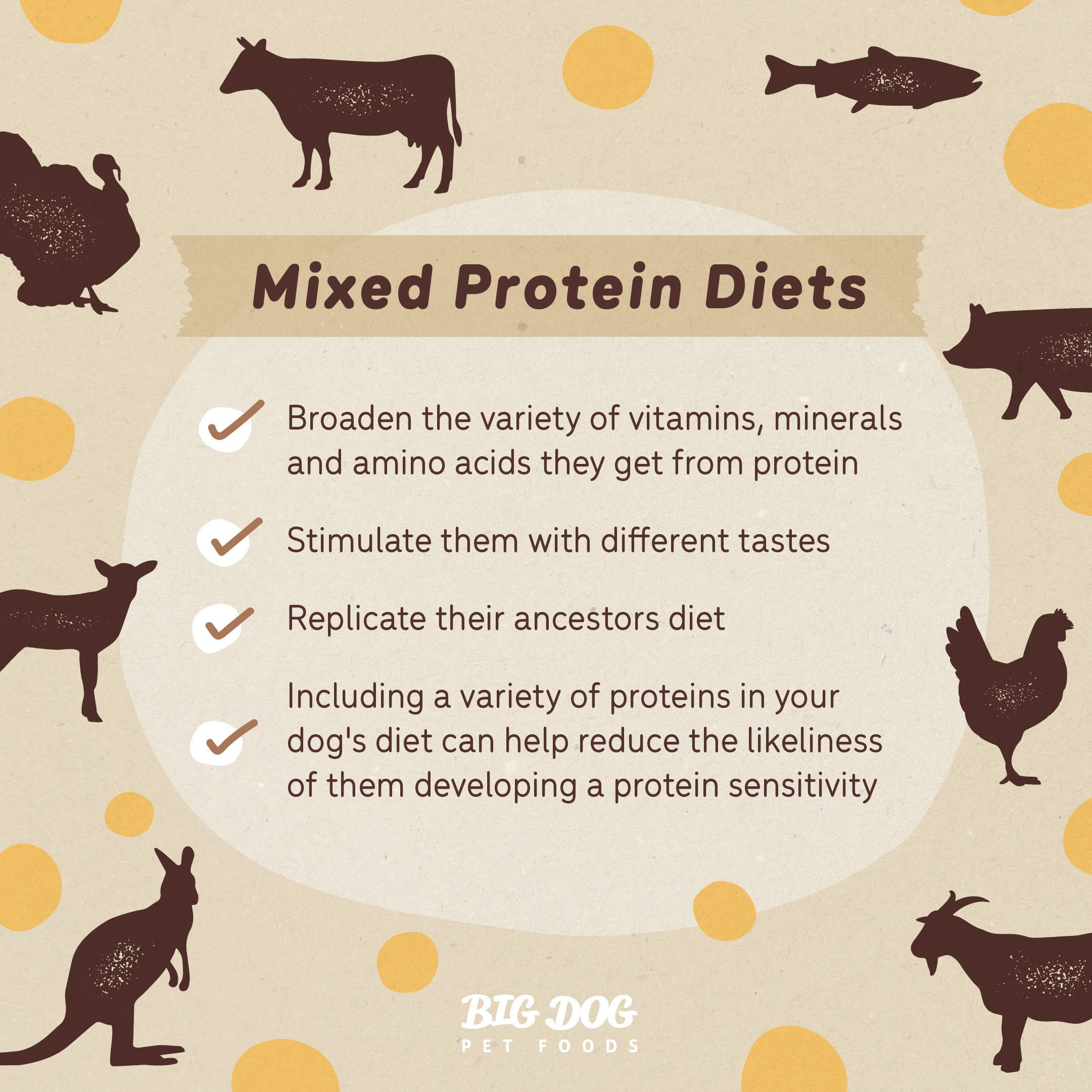
Red Meat
Red meat is so called because of its colour. This colour is due to a higher presence of the protein myoglobin.
Beef and lamb are two of the red meats we use in all of our mixed protein diets. These are two of Australia’s most popular and highly consumed red meats, and for good reason! They are an excellent source of iron, zinc, selenium, B12, B6 and phosphorous, as well as creatine and taurine.
In their raw form, these nutritional levels remain at their highest and these nutrients perform various functions for our dogs.
Selenium is an essential trace mineral for dogs. It acts as an anti-oxidant, assists in hormone metabolism and immune function.
Iron is essential to all living organisms and performs multiple functions. The most important of these is oxygen transport through the body however iron, like zinc, is a component of many important enzymes.
Zinc is also an essential trace mineral for dogs having many essential functions. It is involved in over 200 enzymes which perform critical functions in the body including those responsible for adequately digesting and metabolising protein, carbohydrates and fat in the diet. It’s also important for skin health, wound healing, healthy growth and metabolism and the maintenance of a healthy immune system.
Vitamin B12 is important in proper red blood cell formation, brain health and neurological function as well as cardiovascular health. Having red meat as a part of your dog’s diet is important to ensure proper functioning in this regard.
Another red meat that features in Big Dog Mixed Protein Diets is pork. There is often confusion over whether or not pork is a red or white meat, however due to its high myoglobin content it’s actually classified as a red meat.
Pork and has a similar nutritional profile to beef and lamb except that it’s not quite as high in iron. What makes this meat unique is its high thiamine (vitamin B1) content. Thiamine is important for many biological processes including carbohydrate metabolism, energy production and is critically important in neurological function.
White Meat
Chicken is the white meat of choice in our Mixed Protein Diets. White meat and red meat are both good sources of protein and essential amino acids with increased bioavailability for pets in their raw state.
One of the things that makes chicken unique is its component of types of fat and total fat content. Chicken is lower in total fat and saturated fat compared to beef and lamb.
Chicken also contains the full spectrum of vitamins and minerals from A to Zinc however chicken is higher in vitamin K, vitamin B3 and vitamin B5 than red meat.
When looking at the detailed nutritional breakdown of individual proteins, it becomes clearer to see how a combination of meats in your dog’s diet is the best way to ensure they will be getting complete and balanced nutrition throughout their lives.
Not just looking at the meat component of chicken, chicken bones have a lower density than other meats, which makes the collagen and gelatine easier to extract, absorb and utilise. These nutrients contribute to bone, joint and skin health throughout life.
Fish
At Big Dog, we use ocean-farmed Salmon from Tasmania as the best source of essential omega-3 fatty acids that help maintain healthy brain function, great for their skin and coat, as well as joint support. Salmon is also a rich source of choline, vitamin A and vitamin E when compared to raw beef. Salmon is also a rich source of vitamin B1, vitamin B12 and selenium.
Offally strong nutrients
Offal contains a powerhouse of nutrients. Liver is a great source of iron, copper and zinc phosphorus, high in vitamin A and also provides protein and fat, while the kidney’s offer essential fatty acids and a range of vitamins such as vitamins A, D, E, K as well as B–complex vitamins. By feeding your dog a food that is balanced with the appropriate amount of offal, means they will be benefiting from naturally occurring vitamins and minerals, without the need for synthetic nutrition. Adding synthetic vitamins to a raw food diet that is already packed full of these nutrients can lead to toxicity and be harmful to your pet.
All raw meat and offal are rich sources of the amino acid taurine, critical to cats and important for dogs to obtain as part of a balanced diet. Cooking damages and alters taurine levels and any cooked or processed diet will require synthetic supplementation of this amino acid to prevent deficiencies.
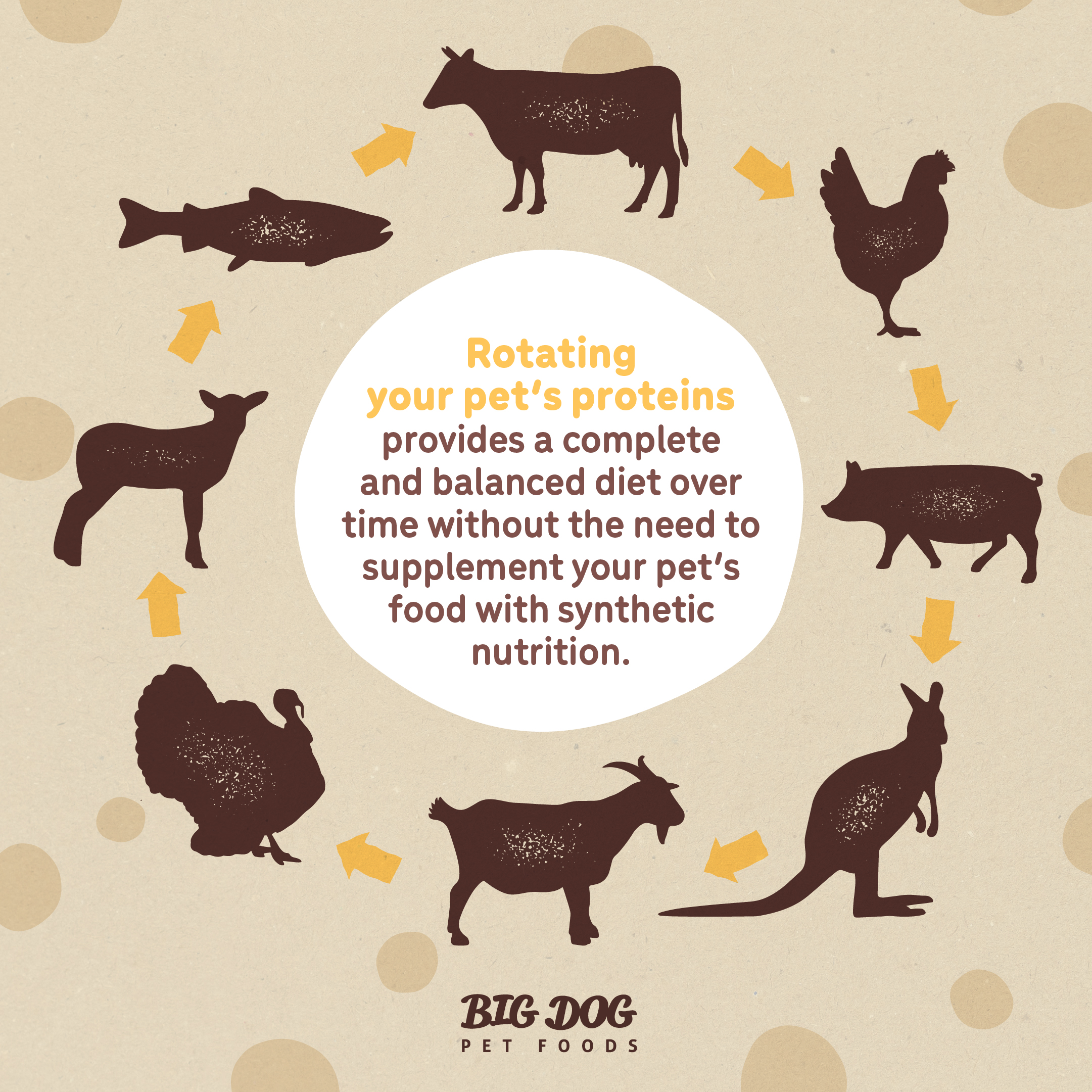
And just a pinch of plant power + superfoods to complete their diet
The ultimate meal for your dog, will be one that also includes a small amount of vegetables, fruits, and other superfoods and healthy ingredients for a complete and balanced meal, naturally.
Seasonal vegetables and fruits, along with superfoods such as egg, wheatgrass and spirulina are loaded with fibre, antioxidants, phytonutrients, anti-inflammatory compounds, and are great for supporting your dog’s immune system.
Feeding a variety of proteins, along with vegetables, fruits, and superfoods, will give them a complete and balanced diet over time, therefore minimising or eliminating the need to include any synthetic vitamins or minerals in your dog’s diet.

No single MVP in our MPDs
Mixed Protein Diets are the best way to replicate your dog’s ancestral diet, the diet they would consume in the wild. When feeding your dog try to think about how your dog would choose to eat if it was their choice. They may have a favourite, but most dogs wouldn’t exclusively eat one animal. Different protein sources and different cuts of meat will provide variety and contribute to “completeness” over time. You can achieve this by feeding mixed-protein meals such as the Big Dog Mixed Protein Diets.
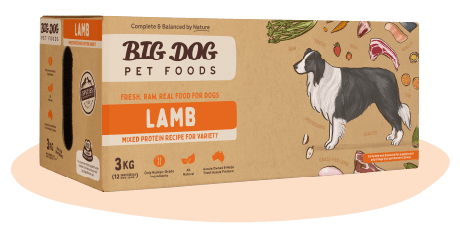

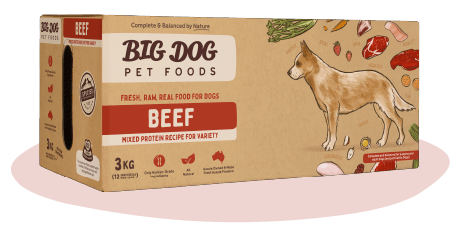
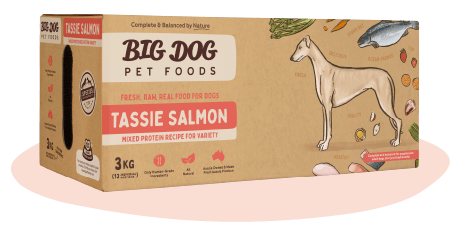
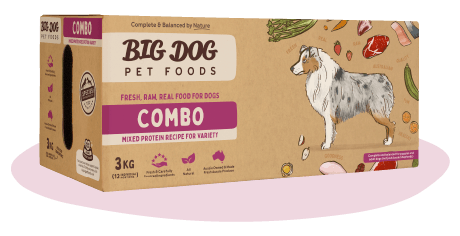
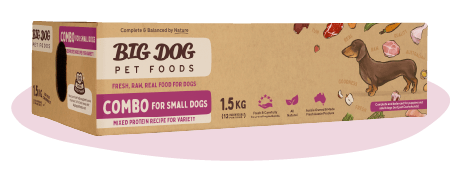
References and links
"Itchy Dogs — Is Food the Problem?" Texas A&M University, August 16, 2012.
Dodd, Jean. "Food Transitioning Versus Food Rotating: What is the Difference? " Dr. Jean Dodd's Pet Health Research Blog, June 25, 2013.
www.nutritionvalue.org
https://www.healthline.com/nutrition
https://www.healthline.com/nutrition/foods/lamb
https://www.healthline.com/nutrition/foods/beef
https://www.healthline.com/nutrition/11-benefits-of-salmon
https://www.nutritionadvance.com/types-of-meat/
van Zelst, M., Hesta, M., Gray, K. et al. Biomarkers of selenium status in dogs. BMC Vet Res 12, 15 (2016). https://doi.org/10.1186/s12917-016-0639-2
Naigamwalla DZ, Webb JA, Giger U. Iron deficiency anemia. Can Vet J. 2012;53(3):250-256.
Valee, BL, Falchuk, KH (1993). “The biochemical basis of zinc physiology”. Physiol. Rev. 73:79-118.
Read DH, Harrington DD. Experimentally induced thiamine deficiency in beagle dogs: clinical observations. Am J Vet Res. 1981 Jun;42(6):984-91. PMID: 7197132.
Read DH, Harrington DD. Experimentally induced thiamine deficiency in beagle dogs: pathologic changes of the central nervous system. American Journal of Veterinary Research. 1986 Oct;47(10):2281-2289.
Kritikos, G.; Parr, J.M.; Verbrugghe, A. The Role of Thiamine and Effects of Deficiency in Dogs and Cats. Vet. Sci. 2017, 4, 59.
https://www.nutritionadvance.com/healthy-foods/red-vs-white-meat/
https://ods.od.nih.gov/factsheets/VitaminB12-HealthProfessional/
https://vetmed.tamu.edu/gilab/research/cobalamin-information/
https://www.nutritionvalue.org/Fish%2C_raw%2C_wild%2C_Atlantic%2C_salmon_nutritional_value.html
https://www.vetmed.ucdavis.edu/sites/g/files/dgvnsk491/files/aal/pdfs/spitze.pdf
